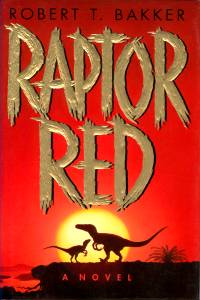Trexmaster’s review of Raptor Red sat gathering dust on the ImpishIdea article shelf for a few years before it was discovered by an archaeological expedition into the “pending” section of textpattern. It was then presented with its long-overdo “live” status.
Articles by trexmaster:

Raptor Red by Robert T. Bakker
Reviewed by trexmaster
Traditionally, dinosaurs in fiction tend to fit into one of two categories: herbivores who look majestic while munching on vegetation in the background, or carnivores (and sometimes angry herbivores) menacing human protagonists such as explorers or anachronistic cave-dwellers. Uncommon is the story where the dinosaurs are the main characters themselves, the characters we are supposed to root for. Raptor Red is one such story.
Set in North America 120 million years ago, during the earlier half of the Cretaceous Period, the book has for a protagonist a female Utahraptor named “Raptor Red” by the author (Utahraptor, for the uninitiated, was a 20-foot-long cousin of Velociraptor). In the first chapter of the book, Raptor Red’s mate gets killed after they bring down a long-necked Astrodon, forcing her to find a new male to pair-bond with. In the meantime, she joins forces with her sister, who is raising offspring of her own. Together, they will brave a flood, famine, dangerous prey, and rival predatory dinosaurs as they struggle to survive the prehistoric world. Eventually Raptor Red does find a male consort, but her sister doesn’t approve of him. Will Raptor Red ultimately mate with her newfound “boyfriend”, or will her sister drive him away?
It must have been challenging to successfully characterize dinosaurs, but I think Bakker did a pretty good job at it. His raptors are ferocious predators you wouldn’t want to meet in a dark forest, yet at the same time they’re thinking, feeling, caring animals, not one-dimensional walnut-brained monsters many laypeople imagine dinosaurs to be, which I find refreshing. The book is also very informative about the various prehistoric creatures that populate Raptor Red’s world, as befits writing by a paleontologist as famous for his work on dinosaurs as Bakker.
However, I think the book does refer too many times to Darwinian evolutionary theory when explaining the dinosaur characters’ actions—-do we really need to know the genetic consequences of every behavior a dinosaur exhibits? In addition, the book has a tendency to mention modern-day objects and animals (e.g. raptor claws are likened to Ginsu knives, armored herbivorous dinosaurs to tanks, etc.); I personally wasn’t too bothered by this, but some readers may wish they were better immersed into the prehistoric world.
Those criticisms having been stated, I enjoyed Raptor Red and highly recommend it to any lover of dinosaurs or animal stories.
Comment [23]
